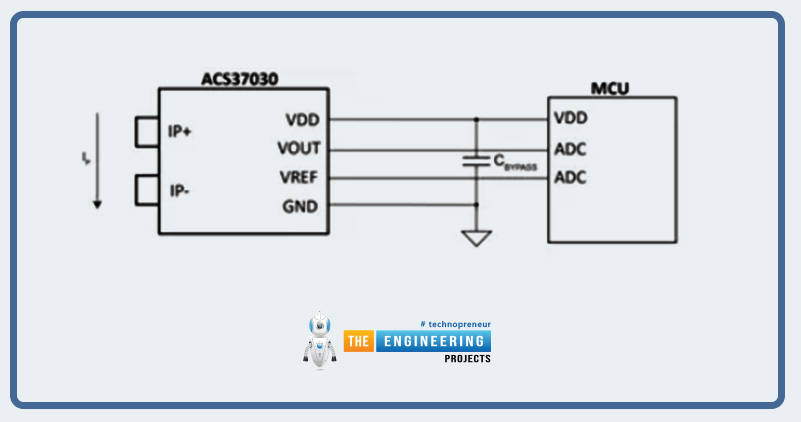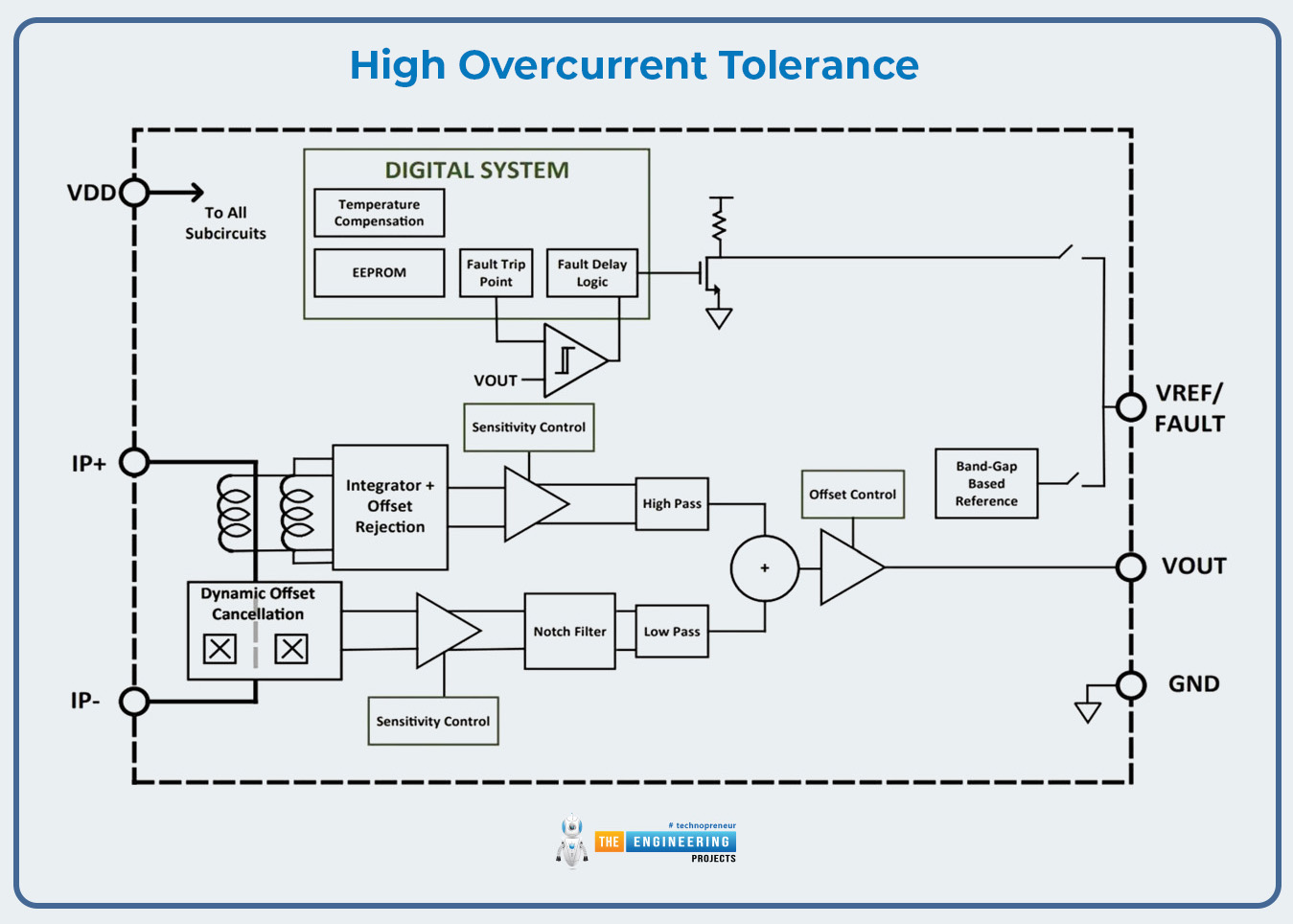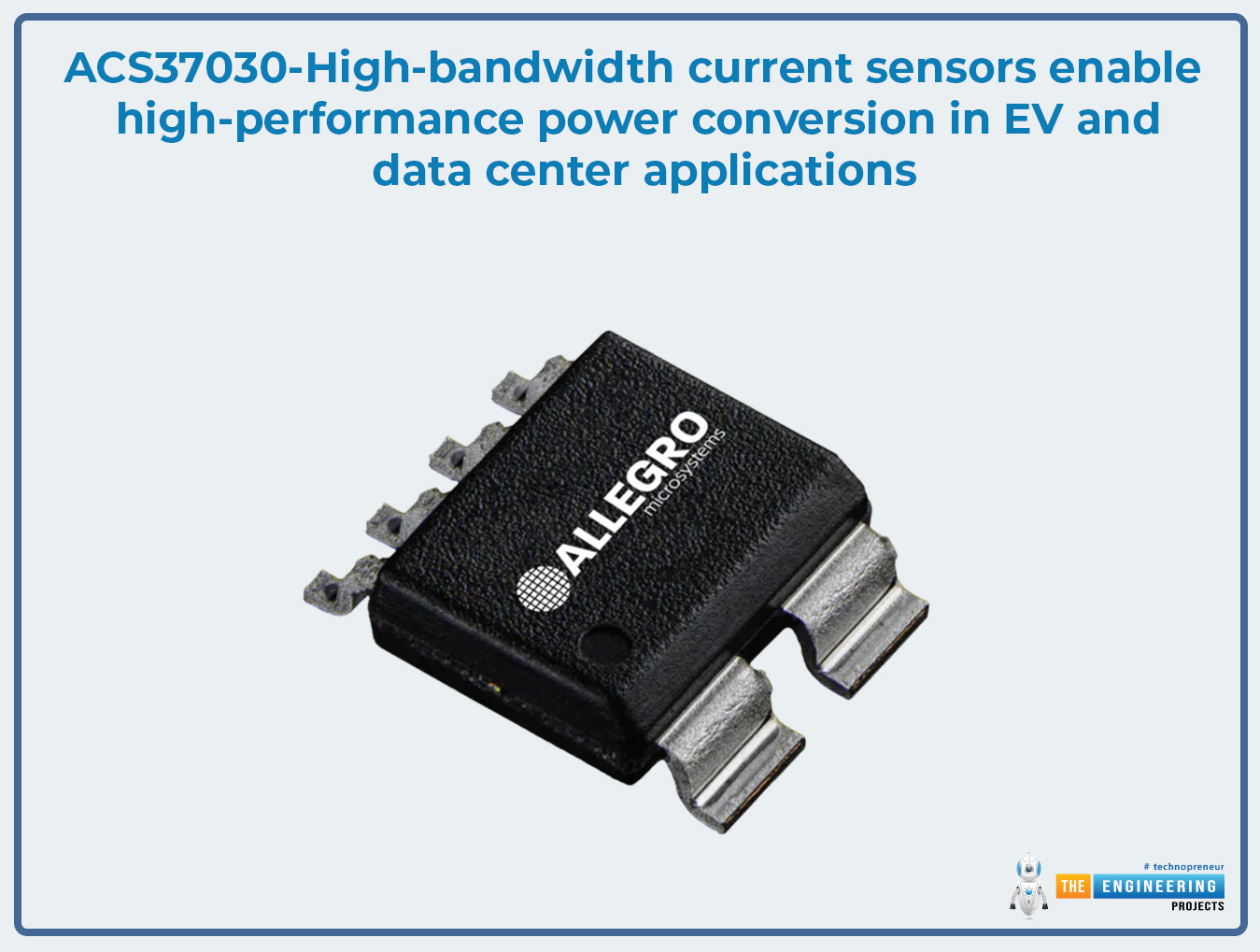
Hi readers! I hope you are fine and spending each day learning more about technology. Today, the subject of discussion is the ACS37030- high-bandwidth current sensors that enable high-performance power conversion in EV and data center applications.
The ACS37030 high-bandwidth current sensor is the answer to high-performance power conversion in Electric Vehicle applications and data centers. The precise current measurement with fast responses gives this a competitive advantage by allowing it to track electricity flow in real-time for proper power system working. With this high-bandwidth capability, it guarantees to measure rapidly changing currents and be very useful for applications involving dynamic environments like EVs, where demands for power change rapidly and quickly in data centers, which demands very efficient management of power so that everything is running as efficiently as possible.
ACS37030 offers the user great accuracy, minimal offset, and excellent noise immunity which means there is no chance for instability under demanding applications. It is well-suited for high-performance power conversion designs where precision and efficiency are critical; it has a small form factor and can easily integrate into existing systems. This device also supports a wide range of operating voltages and provides an analog output, facilitating simple interfacing with numerous control systems. Whether it's monitoring battery charging/discharging in EVs or power supply management in data centers, the ACS37030 delivers the performance needed to optimize power conversion processes and improve energy efficiency.
This article will discover its introduction, features and significations, working and principle, pinouts, datasheet, and applications.

Introduction:
- The ACS37030 is a precision current sensor that is used for high-bandwidth applications. It is used for real-time current monitoring in dynamic environments.
- It supports high-performance power conversion in applications such as Electric Vehicles (EVs) and data centers, ensuring efficient energy use.
- It provides high accuracy with low offset and minimal drift, making it reliable for precise power system monitoring.
- Its response speed ensures this sensor can withstand changes in current due to varying demands, especially if the load has fluctuation in a system.
- It can fit within tightly confined space designs owing to its minimal footprint and effortless integration.
- This sensor allows operation across an extensive voltage range, adapting to differing requirements in most systems.
- Excellent noise rejection ensures stable performance in electrically noisy environments such as data centers and EV powertrains.
- Suitable for battery management in EV, DC-DC converters, inverters, and power management systems in data centers.
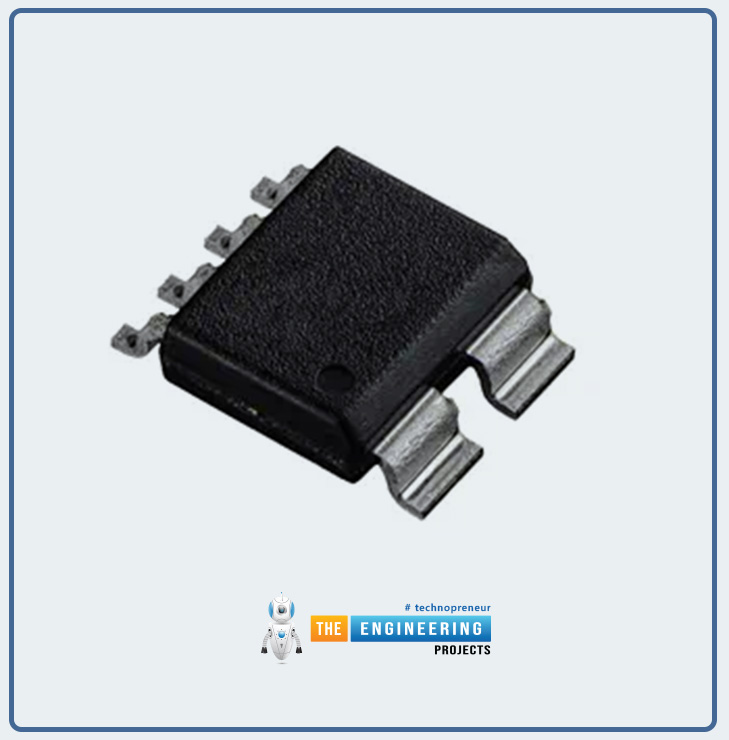
Datasheet:
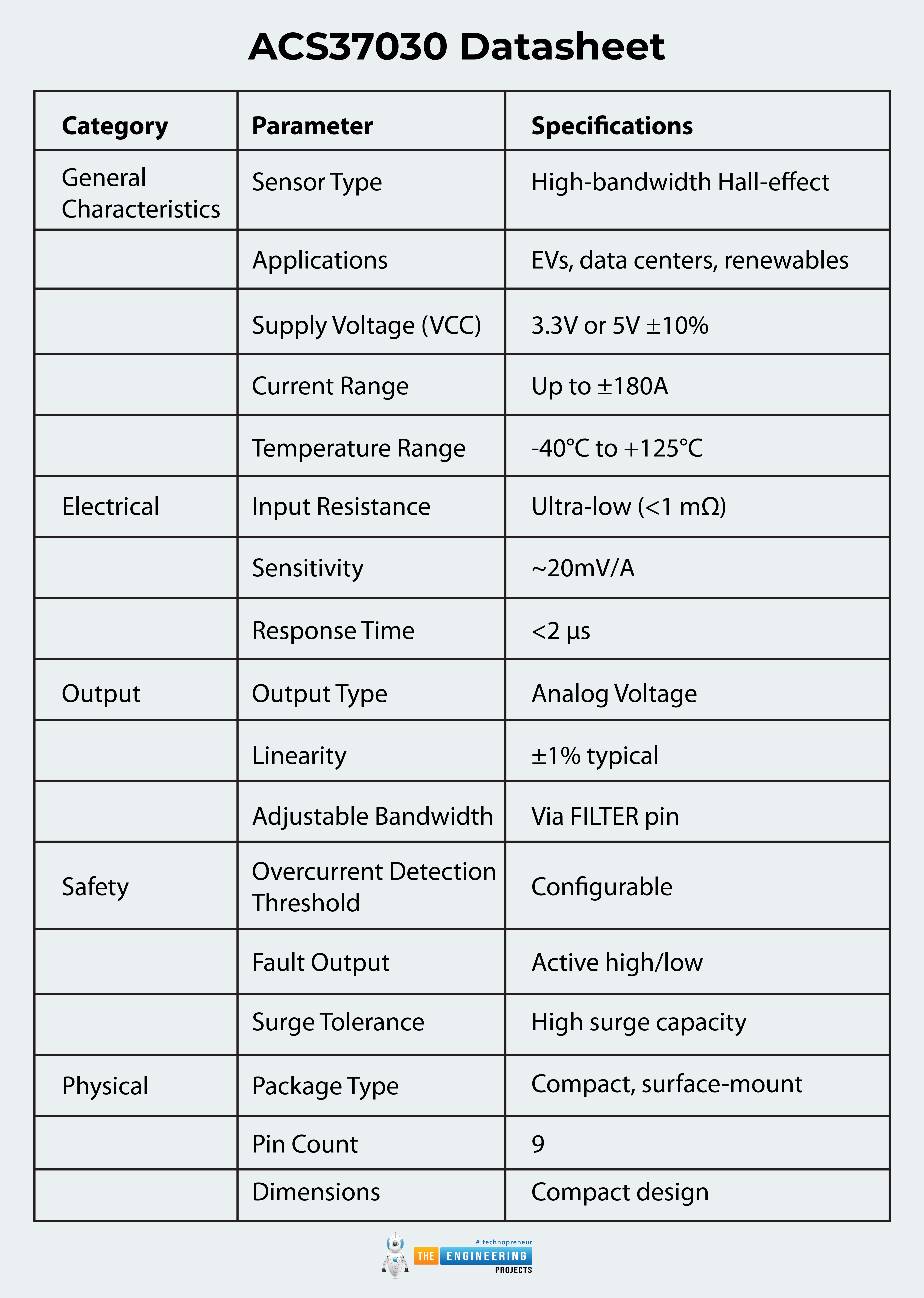
Category |
Parameter |
Specifications |
General Characteristics |
Sensor Type |
High-bandwidth Hall-effect |
Applications |
EVs, data centers, renewables |
|
Supply Voltage (VCC) |
3.3V or 5V ±10% |
|
Current Range |
Up to ±180A |
|
Temperature Range |
-40°C to +125°C |
|
Electrical |
Input Resistance |
Ultra-low (<1 mΩ) |
Sensitivity |
~20mV/A |
|
Response Time |
<2 µs |
|
Output |
Output Type |
Analog Voltage |
Linearity |
±1% typical |
|
Adjustable Bandwidth |
Via FILTER pin |
|
Safety |
Overcurrent Detection Threshold |
Configurable |
Fault Output |
Active high/low |
|
Surge Tolerance |
High surge capacity |
|
Physical |
Package Type |
Compact, surface-mount |
Pin Count |
9 |
|
Dimensions |
Compact design |
Pinouts:
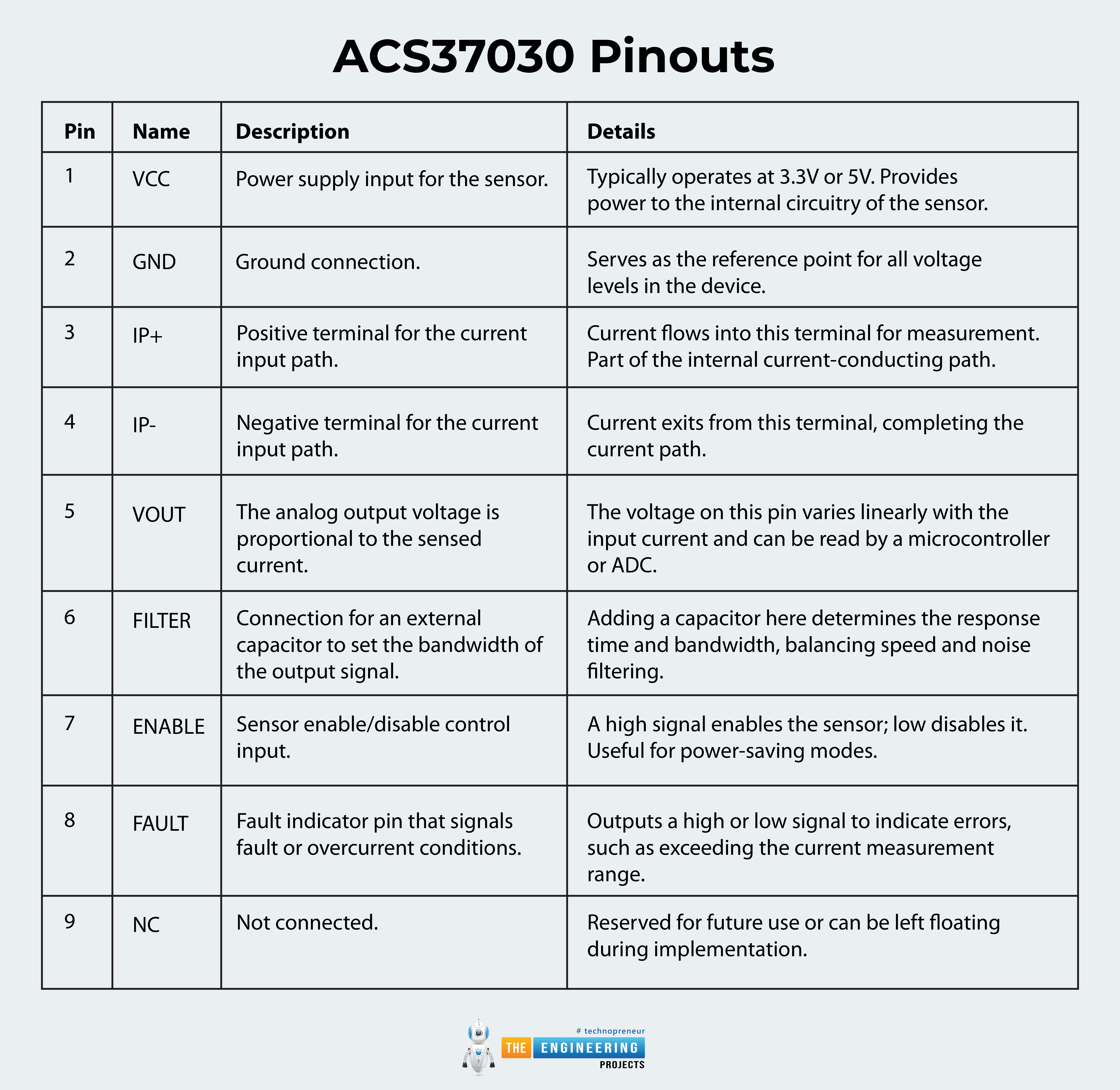
Pin |
Name |
Description |
Details |
|---|---|---|---|
1 |
VCC |
Power supply input for the sensor. |
Typically operates at 3.3V or 5V. Provides power to the internal circuitry of the sensor. |
2 |
GND |
Ground connection. |
Serves as the reference point for all voltage levels in the device. |
3 |
IP+ |
Positive terminal for the current input path. |
Current flows into this terminal for measurement. Part of the internal current-conducting path. |
4 |
IP- |
Negative terminal for the current input path. |
Current exits from this terminal, completing the current path. |
5 |
VOUT |
The analog output voltage is proportional to the sensed current. |
The voltage on this pin varies linearly with the input current and can be read by a microcontroller or ADC. |
6 |
FILTER |
Connection for an external capacitor to set the bandwidth of the output signal. |
Adding a capacitor here determines the response time and bandwidth, balancing speed and noise filtering. |
7 |
ENABLE |
Sensor enable/disable control input. |
A high signal enables the sensor; low disables it. Useful for power-saving modes. |
8 |
FAULT |
Fault indicator pin that signals fault or overcurrent conditions. |
Outputs a high or low signal to indicate errors, such as exceeding the current measurement range. |
9 |
NC |
Not connected. |
Reserved for future use or can be left floating during implementation. |
Features:
High Bandwidth Current Measurement:
The ACS37030 is a high-bandwidth current measurement device. This gives it the capability to measure even the most dynamic changes in electrical signals. In powertrains for EVs, such bandwidth ensures that the high currents change due to acceleration, braking, and loading conditions. In data centers, the varying power demands can be accurately measured and optimized for efficiency in terms of energy use.
Bandwidth Range:
The sensing device supports wide bandwidth operations to suit fast-switching applications such as DC-DC converters and inverters.
Rapid Response Time:
It delivers real-time current monitoring, which is crucial to control in high-speed power electronics.
High accuracy and precision:
The ACS37030 comes with advanced sensing technology, which ensures highly accurate measurement of currents even in the presence of other external noise or temperature variations.
Low Offset Drift:
Tracks measurement accuracy over time and even under different operating conditions.
High Resolution:
Returns accurate analog output that follows measured currents with minimal errors to serve critical applications, including battery management systems.
Calibration-Free Operation:
The sensor achieves excellent results without involving a process of complex calibration for any system, which can shorten the time and cost of setting up.
Extremely Wide Current Sensing Range:
The sensor is designed to measure a wide range of currents, from high current to low current scenarios.
Bidirectional Current Sensing:
It can measure positive and negative currents, thus versatilely used in applications like charging and discharging cycles in EV battery systems.
High Overcurrent Tolerance:
The ACS37030 can withstand and measure high surge currents without damage, which enhances its reliability in power-intensive environments.
Robust Noise Immunity:
ACS37030 is robust and has immunity to electric noise. This means it has stability and accuracy in the measurement.
Electromagnetic Compatibility (EMC):
Designed to work reliably under the influence of electromagnetic interference from other components.
Low Signal-to-Noise Ratio (SNR):
Ensures that the output signal from the circuit is clean, and thus minimal noise would mean that there would be minimal errors during data interpretation
Compact and Integrated Design:
The ACS37030 is a compact form factor, allowing it to be easily integrated into space-constrained designs.
Small Footprint:
Ideal for applications where board space is limited, such as in compact inverters or portable devices.
Integrated Features:
The inclusion of critical components such as the filter pin for bandwidth adjustment simplifies the design and reduces the need for external components.
Fault Detection and Protection:
The sensor has advanced fault detection capabilities for the system's safety and reliability.
Overcurrent Detection:
The fault pin indicates the condition when the current exceeds a defined threshold, thus enabling immediate protective actions.
Self-Protective Features:
Capable of withstanding high transient currents without sustaining damage, thus protecting the sensor and the connected systems.
Flexible Output Options:
The ACS37030 provides an analog output proportional to the sensed current, allowing it to be compatible with various systems.
Linear Output:
The input current to the output voltage follows a linear relationship that makes data handling easy.
Adjustable Bandwidth:
The filter pin allows the adjustment of bandwidth on specific applications, making it possible to match response time with noise removal.
Operating Range:
Highly adaptable to various operational conditions in different environments
Voltage Compatibility:
Operate with either 3.3V or 5V supply voltages by allowing it to fit systems designed for different voltages.
Temperature Range:
Operates within an extreme temperature range from -40°C to +125°C. This makes the product useful for automotive and industrial use.
Bidirectional Current Sensing:
This means that the ACS37030 measures current in two ways forward and reverse, which finds applications in many fields including bidirectional inverters, the regenerative braking systems applied in electric vehicles, and battery management systems.
System Control Enhancement:
Monitoring of charging and discharging currents
Enhanced Efficiency:
Optimized power usage in the most sensitive of systems
Ease of Integration:
The ACS37030 is designed for seamless integration into new and existing systems, reducing design complexity and time to market.
Standard Interfaces:
Simple pin configuration ensures compatibility with most microcontrollers and power management units.
Minimal External Components:
Integrated features reduce the need for additional components, simplifying circuit design and reducing costs.
Energy Efficiency:
The sensor has low power consumption that contributes to overall system efficiency, thus making it the best choice for applications that aim at energy conservation.
Low Heat Generation:
Reduced energy losses lead to minimal heat production, thus extending system reliability.
Optimized for Battery-Powered Devices:
Ensures long battery life in portable applications.
Safety and Reliability:
The ACS37030 is designed with safety and reliability at its core, thus ensuring dependable performance in critical systems.
Overcurrent Protection:
This system prevents damage from overloads by alerting the system to fault conditions.
Solid Construction:
Resists mechanical and thermal stress for long-lasting reliability.
Scalability and Customization:
The sensor is flexible enough to adapt to many applications, catering to a broad range of current sensing applications.
Scalable Design:
It accommodates small-scale devices as well as large power systems with equal ease.
Customizable Features:
Filter pin allows users to fine-tune the sensor according to the application.
Working Principle:
Generation of a Magnetic Field by Flow of Current:
The inner conducting current-carrying rod of the ACS37030 produces a magnetic field across the rod when the rod is conducting electric current based on Ampère's law. The strength and orientation of this magnetic field depend upon the magnitude and orientation of the current.
Measurement of the Bidirectional Current :
ACS37030 can measure forward and backward currents. Since it measures the polarity of the magnetic field, it gives information about the flow of the current, forward or backward.
No Contact with Direct Interference:
It does not interfere with the flow of the current since it's located next to the current path, the loss of power is also minimal.
Hall-Effect Sensing:
The ACS37030 has at its heart a Hall-effect sensor that picks up the magnetic field, which is produced by current. The Hall voltage appears when the magnetic field induces a voltage in the Hall element, and it depends on the strength of the field.
Hall Voltage Output:
This voltage directly corresponds to the current flowing through the conductor.
IMC stands for Integrated Magnetic Concentrator (IMC):
It is applied in the ACS37030 to focus the magnetic field on the Hall element and hence increase the sensitivity of the Hall sensor. It, therefore, becomes very accurate and possible to measure currents with high precision even at low currents.
Signal Conditioning:
The raw signal coming from the Hall-effect sensor is inherently low in amplitude and is easily distorted by noise or variations in temperature. The ACS37030 has built-in circuitry for signal conditioning.
Amplification:
Amplifies the Hall voltage to obtain a stronger signal for further processing.
Temperature Compensation:
The sensor compensates for the temperature-induced variations in the properties of the magnetic field and the Hall element to have wide range accuracy from -40°C to +125°C
Noise Filtering:
There is the application of advanced techniques used in filtering out the noise electrical to ensure stable, reliable output.
Generation of Analog Output:
After conditioning, the processed signal appears as a proportional analog output voltage in the form of magnitude with the direction of the current passed through the sensor.
Straight Line Output:
The ACS 37030 gives an actual linear relationship between the detected current and the output that is easy to interpret for integrating data and systems.
Adjustable Bandwidth:
A filter pin allows users to connect an external capacitor to modify the output signal’s bandwidth. This enables customization of the sensor’s response time and noise filtering for specific applications.
Fault Detection and Safety Mechanisms:
The ACS37030 includes additional circuitry for fault detection, enhancing its safety and reliability in critical applications.
Overcurrent Detection:
The sensor detects the overcurrent condition and sends an output signal to indicate the fault. This is the most important feature for the protection of connected systems from overcurrents that may damage them.
Robust Design:
The device is designed to withstand transient overcurrents without sustaining damage, thus it lasts longer.
Integration into Power Systems:
The ACS37030 is designed to be seamlessly integrated with modern power systems where continuous current monitoring takes place and facilitates efficient power conversion. Its accurate measurements are of use in applications such as motor control in electric vehicles, energy management in data centers, and fault detection in renewable energy systems.
Energy Efficiency:
Accurate measurement of current helps optimize the consumption of power, reduce losses, and improve the overall system efficiency.
Real-Time Monitoring:
High-speed response from the sensor can enable real-time tracking of current changes, which can be vital in dynamic systems with shifting loads.
Applications:
Here are the applications of the ACS37030 current sensor with headings and a 200-word description:
Electrical Vehicles (EVs): The ACS37030 is critical in monitoring systems for battery management, powertrains, and charging circuits in electric vehicles. It optimizes energy consumption and enhances system performance.
Data Centers: In the data center, the sensor is used to monitor the power supply, optimize energy consumption, and detect overcurrent conditions to protect sensitive equipment. In this way, efficiency can be enhanced and downtime minimized.
Renewable Energy Systems: The sensor is used in solar inverters and wind turbine controllers to measure current with precise accuracy for efficient energy generation and distribution.
Industrial Applications: The ACS37030 is used in industrial settings in motor control, robotics, and power distribution systems. It ensures reliable performance, energy optimization, and operational efficiency.
Uninterruptible Power Supplies (UPS) : The sensor ensures stable power delivery during the outage and provides backup power with improved system reliability for UPS systems.
Smart Grids: ACS37030 contributes to system stability and safety and real-time monitoring of power in smart grids, ensuring efficient energy flow and reliability of the grid.
Conclusion:
The ACS37030 current sensor presents an advanced solution with high-bandwidth, high-precision current sensing applicable in various fields. What makes it very essential are its real-time, accurate current measurement capabilities in applications like electric vehicles, data centers, renewable energy systems, and any industrial applications. This sensor checks overcurrent conditions to realize optimal energy management, system efficiency, and safety with the help of powerful advanced power management systems.
It helps the electric cars with battery management and monitors the powertrain as well for a smooth movement of electricity through the automobile. Datacenter: Improved energy efficiency, less downtimes, and safeguarded critical infrastructure due to better performance. Renewables application- for inverter applications like solar inverters, and wind turbines among others that enable it to achieve real-time energy-generation and -distribution monitoring.
ACS37030 has the added aspect of industrial application, primarily in motor control and robotics. The device offers reliable performance and efficiency for UPSs and smart grids, thereby creating system stability for reliable power delivery with the added guarantee of sustainability.
In summary, the ACS37030 is a resource for any application where accurate current measurement is necessary to deliver superior performance and reliability, further optimizing the energy systems in any particular industry. The integration of high accuracy, fast response, and robustness guarantees its permanence as an integral element in sophisticated power management solutions.



